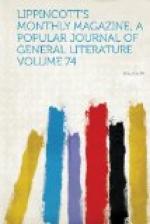It is difficult to describe the perennial beauty of the hemlock trees, with their dark, rich foliage-masses and aromatic odor. It seems a sacrilege to destroy them so ruthlessly. When stripped of their bark and stained with the dark-red sap, they look like fallen giants spoiled of their armor, lying there prone and white-naked, as if there had been a battle of the giants and the gods. These giants were perfumed, it seems. Their huge green plumes are now withered and torn, and their red blood oozes slowly from their bodies in thin and trickling streams. You think of Ossian’s heroes, of Thor and his hammer, of the Anakim or of the steeple-high Brobdignagian cavalry, and almost expect to hear groans issuing from the colossal trunks that cumber the ground on every side.
Everything is on a large scale in these mighty forests. The horizon of your life noiselessly widens, rolls gradually back into immeasurable distances, and “deepens on and up.” There is elasticity and stretch in your thoughts. If you have read Richter, his towering, godlike dreams of time and eternity here find their fit interpretation. He had his Fichtelgebirge, and you have your hemlock mountains. Life seems heroic once more: you exult in existence, and fondly think that here you could be happy for ever. To live far away from the cruel, hurrying world in a sweet little hamlet you wot of, sunk in the heart of the mountains at the bottom of a deep, mossy mountain-chalice—a chalice of richest chasing and filled with the pure wine of God, the mountain-air; to live there during the long summer days; to stand in the flush of dawn with bared head and inhale the fragrance of the dew-drenched grass and the scarlet balsams; to walk with hushed step through the wide forests, communing with the powerful sylvan spirits that labor there, watching with what miraculous delicacy of touch their unseen fingers weave the rich fantastic shrouds of fern and moss that deck the dead and fallen trees or anon give to the living their faint and mottled tints of green and gray;—to live thus through the summer hours, and through autumn, winter, spring watch the unrolling of the gorgeous scroll of Time,—this, you think, were living to some purpose!—WILLIAM SLOANE KENNEDY.
OUR MONTHLY GOSSIP.
THE PARIS SALON OF 1880.
The Salon (official) catalogue contains this year 696 pages. There are 3957 paintings exhibited; 2085 designs, sketches in charcoal and watercolors; 30 engravings on stone, etc.; 111 designs for architecture; 46 specimens of lithography; 701 pieces of sculpture; 305 eaux-fortes; and 54 specimens of monumental art—in all 7280 objects. Though we all thought last year that the number of paintings exhibited was immense, this year the number is 917 more. Alas for the poor critics! How many an additional ache that implies for them! Still, as we have a cozy reading-room at the Palais de l’Industrie—an innovation of this season for the benefit of those who get tired of looking at the pictures and wish to “take a rest”—the weary critic may enter and take a seat (if he can find one unoccupied, which is highly improbable), and there write out his “notes,” as I am doing at this moment.




